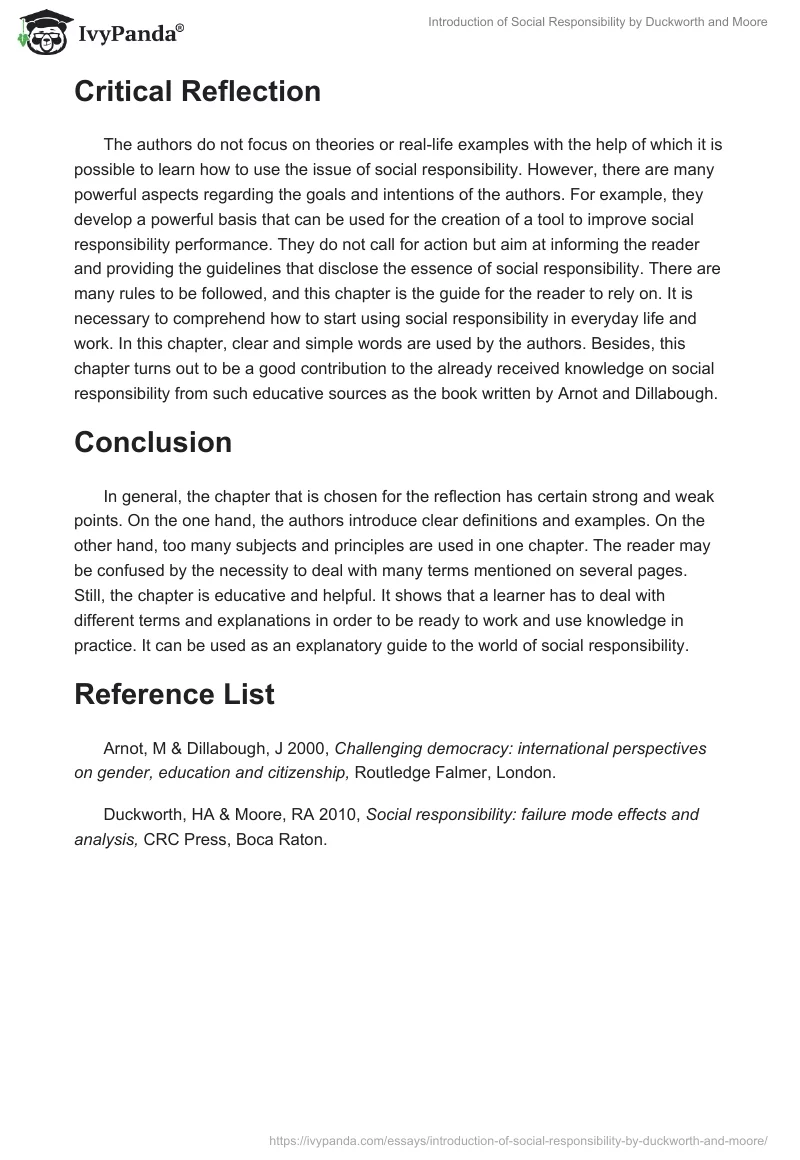Introduction
This course aims at developing the skills in understanding such crucial philosophical and political concepts as human rights, environmental stewardship, and education. The development of a sense of social responsibility is a key factor in education because it helps to connect classroom compliance and citizenship (Arnot & Dillabough 2000). In this paper, a critical reflection on social responsibility explained by Duckworth and Moore in their “Social Responsibility: Failure Mode Effects and Analysis” will be given. The authors of the first chapter “An Introduction to Social Responsibility” begin with the definition of the term “social responsibility” and introduce a number of contexts within the frames of which it is possible to comprehend the chosen term. The attention to the subjects and principles of ISO 26000 prove the correct direction chosen in the chapter and the importance of relying on a globally consistent standard that is applicable to social responsibility (Duckworth & Moore 2010).
Key Points
The goal of the first chapter in the book is to develop an informative introduction to social responsibility. The key points in addition to the definition include the discussion of the principles and examples which define the essence of social responsibility. These principles are accountability, ethical behavior, transparency, and respect for people’s interests, law, and human rights (Duckworth & Moore 2010). Besides, there are seven core subjects with the help of which the reader comprehends the worth of social responsibility in education and everyday life. Unethical behaviors and the importance of human rights’ recognition may influence organizational governance in different ways, and people should learn how to use these terms, guide each other, and promote organizational success. For example, environmental issues are defined as crucial for learners because they help to promote sustainability in the work and support life management (Duckworth & Moore 2010).
Critical Reflection
The authors do not focus on theories or real-life examples with the help of which it is possible to learn how to use the issue of social responsibility. However, there are many powerful aspects regarding the goals and intentions of the authors. For example, they develop a powerful basis that can be used for the creation of a tool to improve social responsibility performance. They do not call for action but aim at informing the reader and providing the guidelines that disclose the essence of social responsibility. There are many rules to be followed, and this chapter is the guide for the reader to rely on. It is necessary to comprehend how to start using social responsibility in everyday life and work. In this chapter, clear and simple words are used by the authors. Besides, this chapter turns out to be a good contribution to the already received knowledge on social responsibility from such educative sources as the book written by Arnot and Dillabough.
Conclusion
In general, the chapter that is chosen for the reflection has certain strong and weak points. On the one hand, the authors introduce clear definitions and examples. On the other hand, too many subjects and principles are used in one chapter. The reader may be confused by the necessity to deal with many terms mentioned on several pages. Still, the chapter is educative and helpful. It shows that a learner has to deal with different terms and explanations in order to be ready to work and use knowledge in practice. It can be used as an explanatory guide to the world of social responsibility.
Reference List
Arnot, M & Dillabough, J 2000, Challenging democracy: international perspectives on gender, education and citizenship, Routledge Falmer, London.
Duckworth, HA & Moore, RA 2010, Social responsibility: failure mode effects and analysis, CRC Press, Boca Raton.


